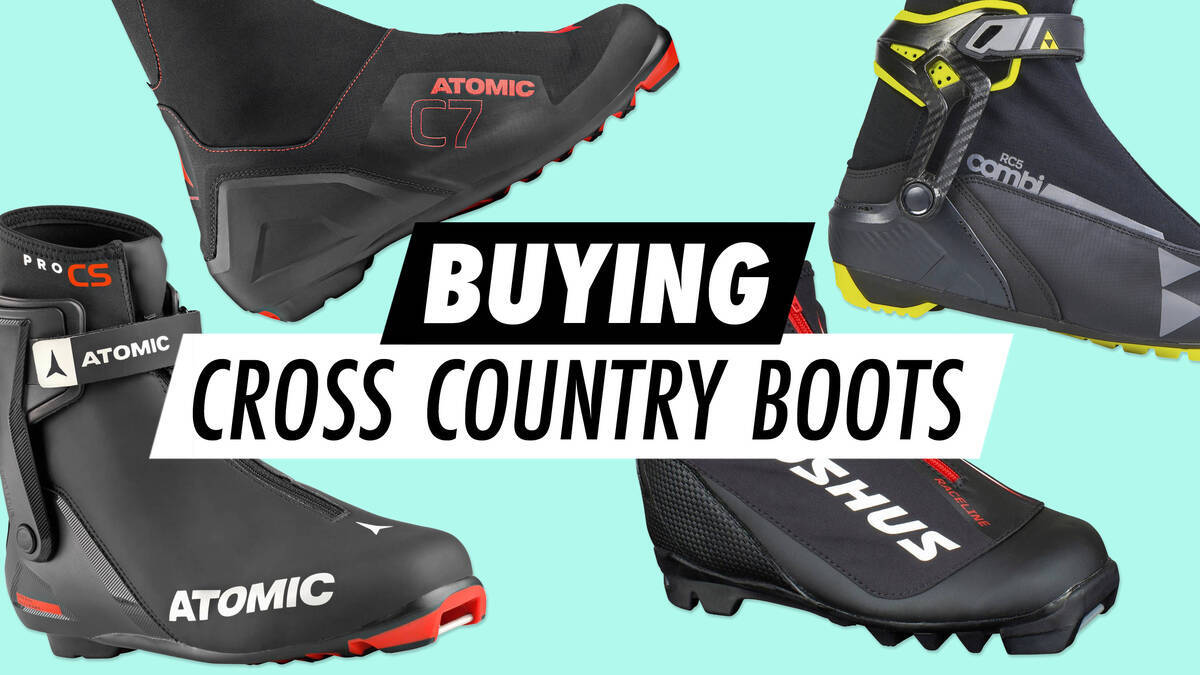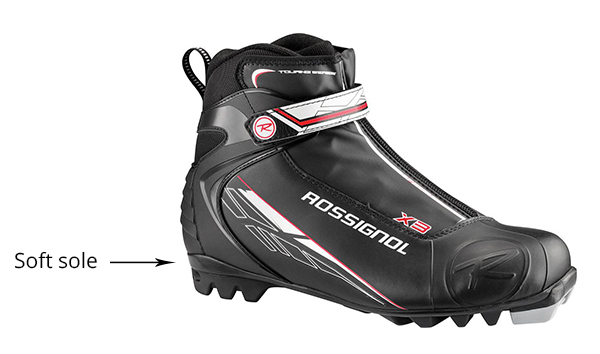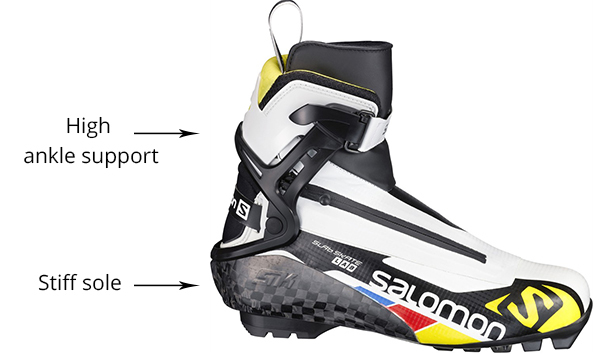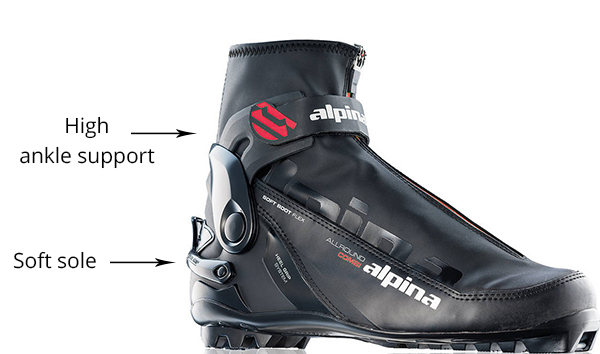Guide to Purchasing Cross-Country Ski Boots

Choosing the right cross-country boots is vital for an enjoyable skiing experience, no matter the skiing style you aim to practice. Here, we've provided essential tips to guide your decision-making process.
Overview
Determining the Right Size for Cross-Country Ski Boots
Cross-country boots ought to hug your heels securely while skiing. The trick is to avoid boots that are overly tight or loose. Ensure there's sufficient room at the front of the boot to give your toes some wiggle space, preventing toe damage from pressure. Excessively tight boots can disrupt your balance and circulation. It's common to wear thicker socks with cross-country ski boots, so consider choosing boots half to a full size larger than your running shoes in such instances.
When purchasing cross-country boots from SkatePro, adhere to the specific boot’s sizing guide you are considering. This practice allows you to compare your foot length with the boots of interest. Our size guides frequently incorporate customer feedback for added insights.
Selecting Cross-Country Skis by Usage: Leisure or Competition
Your choice of cross-country ski boots must correspond with how you plan to use them. The design of cross-country boots differs based on whether they're intended for leisurely outings or competitive events like Sweden's renowned Vasaloppet race.
Recreational Cross-Country Boots
Prioritizing comfort and user-friendliness is essential for recreational cross-country skiing. These boots emphasize warmth and ease with a relaxed fit, ideal for extended outings. For novices and children eager to frolic in the snow, these characteristics are particularly appealing.
Competitive Cross-Country Boots
Boots geared towards athletic performance typically offer a snugger, more precise fit. This fit optimizes power transmission from your legs to your skis. To boost speed and agility, these boots incorporate lightweight materials, such as carbon. Competitive cross-country skis prioritize performance over comfort, catering to seasoned skiers.
Types of Cross-Country Ski Boots
There are four distinct types of cross-country ski boots suitable for different skiing styles. This section includes a fifth type designed specifically for roller skiing.
Classic Cross-Country Ski Boots - Soft and Flexible Soles

Classic cross-country boots feature pliable soles to enable the necessary foot flexing needed for traditional cross-country strides.
Whether you're an avid skier or just starting, if you engage in classic cross-country skiing, you'll find appropriate boots in this category. Beginners should focus on warmth with thicker liners and opt for boots that support the heel and ankles, suitable for an annual winter getaway or participating in the Vasaloppet for the first time.
For more experienced skiers, classic boots are typically lighter with thinner liners to minimize interior warmth during high performance. They also feature a stiffer heel counter to enhance power transfer.
Explore our collection of Classic Cross-Country Ski Boots.
Skate Ski Boots - Elevated Ankle Support and Firm Soles

Unlike classic cross-country ski boots, skate ski boots cater to the distinct requirements of skating strides, which apply considerable lateral pressure on the ankles. To accommodate this, skate boots are engineered with robust, elevated ankle braces constructed from materials like plastic or carbon.
The rigid sole design in skate boots allows for kicks using the entire sole, contrasting the forefoot-only thrust in classic skiing, resulting in more powerful kicks.
Discover our range of Skate Ski Boots.
Cross-Country Combi Boots - Balance of Flexibility and Ankle Support

For enthusiasts of both skate and classic skiing desiring a single pair of boots, or those requiring additional ankle support for classic skiing, combi boots are a worthwhile option.
By integrating features from both styles, combi boots provide substantial ankle support essential for skating while maintaining the flexible sole needed for classic push-offs, a challenging task when using skate boots.
Check out our cross-country combi boots within our selections of Skate Ski Boots or Classic Cross-Country Ski Boots.
Backcountry Ski Boots - Designed for Durability and Weather Resistance
Backcountry ski boots are crafted for wilderness exploration and come equipped with features to maximize your adventure experience. They often resemble regular hiking boots and prioritize warmth and comfort, crucial for prolonged travels in remote areas. Their high cuffs offer ankle support and prevent snow intrusion.
In summary, for backcountry excursions, choose boots tailored for the task, meaning they should be sturdy, comfortable, and waterproof nnn bc boots.
Explore our collection of Backcountry Ski Boots.
Rollerski Boots - Emphasizing Ventilation
It's common to use cross-country ski boots for off-season roller skiing, which generally works. However, if you find your feet overheating during summer training, consider purchasing summer roller ski boots for NNN bindings (NIS). These boots offer superior ventilation and are lighter than traditional cross-country ski boots.
Be mindful that using your cross-country boots for rollerskiing can cause accelerated wear, especially around the zipper. Extend their lifespan by regularly cleaning off dirt and storing them in a dry place when not in use.
Check out our selection of Roller Ski Boots.
Ensuring Boot and Binding Compatibility for Cross-Country Skiing
Before purchasing, it's essential to confirm that your cross-country boots and bindings are compatible. The alignment of cross-country boots with bindings, or vice versa, depends on matching boot soles with appropriate bindings.
Utilizing the chart below, you have two options for assessment. First, identify your cross-country boots to find all compatible binding types. Alternatively, determine your ski bindings to see which boots are compatible. This strategy aids in selecting boots that pair well with your bindings.
```html
Compatibility of Cross Country Boots and Bindings
| NNN Bindings | Prolink Bindings | Turnamic Bindings | SNS Profil Bindings (Classic) | SNS Pilot Bindings (Skate) | NNN BC Bindings | |
|---|---|---|---|---|---|---|
| Alpina Boots | x | x | x | |||
| Atomic Prolink Boots | x | x | x | |||
| Atomic SNS Pilot Boots (Skate) | x | |||||
| Atomic SNS Profil Boots (Classic) | x | |||||
| Fischer Boots | x | x | x | |||
| Madshus Boots | x | x | x | |||
| Rossignol Boots | x | x | x | |||
| Salomon Prolink Boots | x | x | x | |||
| Salomon SNS Pilot Boots (Skate) | x | |||||
| Salomon SNS Profil Boots (Classic) | x | |||||
| Alpina, Fischer or Madshus NNN BC Boots | x |
For a complete overview of cross country and roller ski binding compatibility with different boots, see our guide Compatibility of Bindings for Cross Country and Roller Skis.
